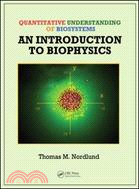Quantitative Understanding of Biosystems ─ An Introduction to Biophysics
商品資訊
定價
:NT$ 3769 元優惠價
:90 折 3392 元
無庫存,下單後進貨(到貨天數約45-60天)
可得紅利積點:101 點
相關商品
商品簡介
作者簡介
目次
商品簡介
Quantitative Understanding of Biosystems: An Introduction to Biophysics focuses on the behavior and properties of microscopic structures that underlie living systems. It clearly describes the biological physics of macromolecules, subcellular structures, and whole cells, including interactions with light.
Providing broad coverage of physics, chemistry, biology, and mathematics, this color text features:
Mathematical and computational tools—graphing, calculus, simple differential equations, diagrammatic analysis, and visualization tools
Randomness, variation, statistical mechanics, distributions, and spectra
The biological micro- and nanoworld—structures, processes, and the physical laws
Quantum effects—photosynthesis, UV damage, electron and energy transfer, and spectroscopic characterization of biological structures
Through its active learning approach, the text encourages practical comprehension of the behavior of biosystems, rather than knowledge of the latest research. The author includes graph- and diagram-centered physics and mathematics, simple software, frequent checks of understanding, and a repetition of important ideas at higher levels or from different points of view. After completing this book, students will gain significant computational and project experience and become competent at quantitatively characterizing biosystems.
CD-ROM Resource
The accompanying CD contains multimedia learning tools, such as video clips and animations, that illustrate intrinsically dynamic processes. For students inexperienced in the application of mathematics and physical principles to naturally occurring phenomena, this multimedia component emphasizes what is most obvious about biological systems: living things move. Students can also manipulate and re-program the included Excel graphs.
Providing broad coverage of physics, chemistry, biology, and mathematics, this color text features:
Mathematical and computational tools—graphing, calculus, simple differential equations, diagrammatic analysis, and visualization tools
Randomness, variation, statistical mechanics, distributions, and spectra
The biological micro- and nanoworld—structures, processes, and the physical laws
Quantum effects—photosynthesis, UV damage, electron and energy transfer, and spectroscopic characterization of biological structures
Through its active learning approach, the text encourages practical comprehension of the behavior of biosystems, rather than knowledge of the latest research. The author includes graph- and diagram-centered physics and mathematics, simple software, frequent checks of understanding, and a repetition of important ideas at higher levels or from different points of view. After completing this book, students will gain significant computational and project experience and become competent at quantitatively characterizing biosystems.
CD-ROM Resource
The accompanying CD contains multimedia learning tools, such as video clips and animations, that illustrate intrinsically dynamic processes. For students inexperienced in the application of mathematics and physical principles to naturally occurring phenomena, this multimedia component emphasizes what is most obvious about biological systems: living things move. Students can also manipulate and re-program the included Excel graphs.
作者簡介
Thomas M. Nordlund is an associate professor in the Department of Physics at the University of Alabama at Birmingham. A Fellow of the American Physical Society, Dr. Nordlund has performed research in biomolecular dynamics for 30 years. He earned his Ph.D. in physics from the University of Illinois at Urbana-Champaign, under the supervision of Hans Frauenfelder.
目次
INTRODUCTION, APPROACH, AND TOOLSIntroduction to a New World Biological and Nonliving Worlds Contrasted Hierarchical Structure and Function Some Important Quantities to Get Started Biophysics and Biochemistry Operate in Water (Water 1) Important or "Hot" Issues in Biophysics, or How to Be Out-of-Date Quickly Is There a Career Here Somewhere? Read Appendix A
How (Most) Physicists Approach Biophysics Dealing with Nonspherical Cows: Drive for Simplicity Two Approaches to BiosystemsComparison of "Physics" and "Biology" Approaches to OrganismsMemorization: Its Advantages and Dangers
Math Tools: First Pass What Math Do We Need? Notation: Mathematics vs. Physics Notations ApproximationsVectors Two- and Three-Dimensional GeometryCalculusDifferential EquationsDistributions
STRUCTURE AND FUNCTIONWater IntroductionStructureUnusual Physical PropertiesSummary of Important Physical Properties Bulk vs. Local Structures Diffusion and Chemical Reactions in Water Solutes and the Solvent Power of Water Points to Remember
Structures: From 0.1 to 10 nm and LargerSoftware to Display and Analyze Biological Structures Solvents Small MoleculesMedium-Sized Molecules: Components of Large BiomoleculesForces and Free Energies BiopolymersMacromolecules: When Does a Molecule Become a Macroscopic Object?Points to Remember
First Pass at Supramolecular Structures: Assemblies of Biomolecules Measuring Properties of Three-Dimensional AggregatesSmall AggregatesLarge AggregatesTwo-Dimensional Aggregates: MembranesPoints to Remember
Putting a Cell Together: Physical Sketch Minimal, Prokaryotic, and Eukaryotic CellsPhysiology: Selective OverviewReproduction, DNA, and the Cell NucleusSensors and Recognition: Responding to the Outside World without Eyes
BIOLOGICAL ACTIVITY: QUANTUM MICROWORLDQuantum Primer Quantum Glossary Schrödinger Equation and Other Tools of Quantum MechanicsPauli Exclusion Principle From Atoms to Molecules Collisions of Atoms and Molecules Classical vs. Quantum: Is a 1-mm-Long Molecule of DNA a Quantum Object?Points to Remember
Light and Life Light: Our Energy Source Crucial Differences between One 5-eV and Two 2.5-eV Photons Properties of PhotonsScattering and RefractionAbsorption SpectraEmission SpectraEinstein Relations between Absorption and Emission of Atoms (Graduate Section)Intersystem Crossing: Singlets (S = 0) to Triplets (S = 1) Energy Transfer (FRET) Points to Remember
Photosynthesis Global Numbers Overall ProcessStructural Organization of Photosynthetic Units Light-Harvesting (Antenna) Proteins: Arrays of AbsorbersReaction Centers and Charge Separation: Purple Bacteria and CyanobacteriaArtificial Models and Nonpolluting Energy Production Points to Remember
Direct Ultraviolet Effects on Biological Systems Types and Sources of UV LightDivisions of the UV for Health Purposes: UV-A, UV-B, and UV-C UV Damage to Organisms: "Action Spectra" Wavelength-Dependent Photochemical Yields and Protein Damage UV Damage to DNAOptical Properties of the Skin SunscreensPoints to Remember
BIOLOGICAL ACTIVITY: (CLASSICAL) MICROWORLDMechanics and Dynamics Conservation Laws, Newton’s Laws, Forces, and Torques Friction: Familiar and Less Familiar Examples of Motion Gravitational Forces Volume Changes and Compressibility Stress and Strain Force of Friction, Dissipation, Inertia, and DisorderFluids and TurbulencePoints to Remember
Random Walks, Diffusion, and Polymer Conformation Review of Kinetic Theory of Gases: Implications for Biomolecular Averaging One-Dimensional Random Walk: Probabilities and Distributions Spreadsheet Model for a One-Dimensional Random WalkThree-Dimensional Random WalkDiffusion in the BulkReprise of Photosynthetic Light Harvesting Biopolymers—A Random ReprisePoints to Remember
Statistical Physics and Thermodynamics Primer Important Quantities: Temperature, Pressure, Density, and Number Statistical Mechanical View and DistributionsEquipartition of Energy"Internal" Energy: Kinetic (K) and Potential (U)Heat, Internal Energy, Work, and Enthalpy Conservative and Nonconservative Forces: DNA Example Ideal Gas Law Entropy: Gases and PolymersFree Energy (Gibbs)Energy Diagrams Boltzmann Distribution if Numbers Vary: Gibbs Distribution Equilibrium Constants in Ideal, Uniform Solutions Free Energy: Enthalpy, Entropy, Mixing, Gradients, Potential, and ATPPoints to Remember
Reactions: Physical View Energy, Entropy, and Free Energy Diagrams Rate Theory I: Activation-Energy Model Diffusion-Controlled Rates (Bimolecular) Effects of Temperature on Rate ConstantsQuantum TunnelingA ⇌ B: Unimolecular Reactions A + B → C Binding Reactions: Free-Solution Reactions Complex Reactions: Rate-Determining Steps and Michaelis–Menten AnalysisDriving Forces Reversibility and Detailed Balance Single-Molecule BehaviorPoints to Remember
Molecular Machines: Introduction Basic Considerations for MotorsDNA-Manipulating MotorsPoints to Remember
Assembly Overview of Assembly IssuesKinetics and Equilibrium Restricted Space for Assembly Entropic Drive: Ordered Structures Can Be Driven by Random ProcessesNucleosomes and Nucleosome-Like StructuresPoints to Remember
Appendix A: Reading Skills and Information Sources Appendix B: Snapshot of the Supporting CD
Glossary
Further Resources
Index
Problem Solving and References appear at the end of each chapter.
How (Most) Physicists Approach Biophysics Dealing with Nonspherical Cows: Drive for Simplicity Two Approaches to BiosystemsComparison of "Physics" and "Biology" Approaches to OrganismsMemorization: Its Advantages and Dangers
Math Tools: First Pass What Math Do We Need? Notation: Mathematics vs. Physics Notations ApproximationsVectors Two- and Three-Dimensional GeometryCalculusDifferential EquationsDistributions
STRUCTURE AND FUNCTIONWater IntroductionStructureUnusual Physical PropertiesSummary of Important Physical Properties Bulk vs. Local Structures Diffusion and Chemical Reactions in Water Solutes and the Solvent Power of Water Points to Remember
Structures: From 0.1 to 10 nm and LargerSoftware to Display and Analyze Biological Structures Solvents Small MoleculesMedium-Sized Molecules: Components of Large BiomoleculesForces and Free Energies BiopolymersMacromolecules: When Does a Molecule Become a Macroscopic Object?Points to Remember
First Pass at Supramolecular Structures: Assemblies of Biomolecules Measuring Properties of Three-Dimensional AggregatesSmall AggregatesLarge AggregatesTwo-Dimensional Aggregates: MembranesPoints to Remember
Putting a Cell Together: Physical Sketch Minimal, Prokaryotic, and Eukaryotic CellsPhysiology: Selective OverviewReproduction, DNA, and the Cell NucleusSensors and Recognition: Responding to the Outside World without Eyes
BIOLOGICAL ACTIVITY: QUANTUM MICROWORLDQuantum Primer Quantum Glossary Schrödinger Equation and Other Tools of Quantum MechanicsPauli Exclusion Principle From Atoms to Molecules Collisions of Atoms and Molecules Classical vs. Quantum: Is a 1-mm-Long Molecule of DNA a Quantum Object?Points to Remember
Light and Life Light: Our Energy Source Crucial Differences between One 5-eV and Two 2.5-eV Photons Properties of PhotonsScattering and RefractionAbsorption SpectraEmission SpectraEinstein Relations between Absorption and Emission of Atoms (Graduate Section)Intersystem Crossing: Singlets (S = 0) to Triplets (S = 1) Energy Transfer (FRET) Points to Remember
Photosynthesis Global Numbers Overall ProcessStructural Organization of Photosynthetic Units Light-Harvesting (Antenna) Proteins: Arrays of AbsorbersReaction Centers and Charge Separation: Purple Bacteria and CyanobacteriaArtificial Models and Nonpolluting Energy Production Points to Remember
Direct Ultraviolet Effects on Biological Systems Types and Sources of UV LightDivisions of the UV for Health Purposes: UV-A, UV-B, and UV-C UV Damage to Organisms: "Action Spectra" Wavelength-Dependent Photochemical Yields and Protein Damage UV Damage to DNAOptical Properties of the Skin SunscreensPoints to Remember
BIOLOGICAL ACTIVITY: (CLASSICAL) MICROWORLDMechanics and Dynamics Conservation Laws, Newton’s Laws, Forces, and Torques Friction: Familiar and Less Familiar Examples of Motion Gravitational Forces Volume Changes and Compressibility Stress and Strain Force of Friction, Dissipation, Inertia, and DisorderFluids and TurbulencePoints to Remember
Random Walks, Diffusion, and Polymer Conformation Review of Kinetic Theory of Gases: Implications for Biomolecular Averaging One-Dimensional Random Walk: Probabilities and Distributions Spreadsheet Model for a One-Dimensional Random WalkThree-Dimensional Random WalkDiffusion in the BulkReprise of Photosynthetic Light Harvesting Biopolymers—A Random ReprisePoints to Remember
Statistical Physics and Thermodynamics Primer Important Quantities: Temperature, Pressure, Density, and Number Statistical Mechanical View and DistributionsEquipartition of Energy"Internal" Energy: Kinetic (K) and Potential (U)Heat, Internal Energy, Work, and Enthalpy Conservative and Nonconservative Forces: DNA Example Ideal Gas Law Entropy: Gases and PolymersFree Energy (Gibbs)Energy Diagrams Boltzmann Distribution if Numbers Vary: Gibbs Distribution Equilibrium Constants in Ideal, Uniform Solutions Free Energy: Enthalpy, Entropy, Mixing, Gradients, Potential, and ATPPoints to Remember
Reactions: Physical View Energy, Entropy, and Free Energy Diagrams Rate Theory I: Activation-Energy Model Diffusion-Controlled Rates (Bimolecular) Effects of Temperature on Rate ConstantsQuantum TunnelingA ⇌ B: Unimolecular Reactions A + B → C Binding Reactions: Free-Solution Reactions Complex Reactions: Rate-Determining Steps and Michaelis–Menten AnalysisDriving Forces Reversibility and Detailed Balance Single-Molecule BehaviorPoints to Remember
Molecular Machines: Introduction Basic Considerations for MotorsDNA-Manipulating MotorsPoints to Remember
Assembly Overview of Assembly IssuesKinetics and Equilibrium Restricted Space for Assembly Entropic Drive: Ordered Structures Can Be Driven by Random ProcessesNucleosomes and Nucleosome-Like StructuresPoints to Remember
Appendix A: Reading Skills and Information Sources Appendix B: Snapshot of the Supporting CD
Glossary
Further Resources
Index
Problem Solving and References appear at the end of each chapter.
主題書展
更多
主題書展
更多書展本週66折
您曾經瀏覽過的商品
購物須知
外文書商品之書封,為出版社提供之樣本。實際出貨商品,以出版社所提供之現有版本為主。部份書籍,因出版社供應狀況特殊,匯率將依實際狀況做調整。
無庫存之商品,在您完成訂單程序之後,將以空運的方式為你下單調貨。為了縮短等待的時間,建議您將外文書與其他商品分開下單,以獲得最快的取貨速度,平均調貨時間為1~2個月。
為了保護您的權益,「三民網路書店」提供會員七日商品鑑賞期(收到商品為起始日)。
若要辦理退貨,請在商品鑑賞期內寄回,且商品必須是全新狀態與完整包裝(商品、附件、發票、隨貨贈品等)否則恕不接受退貨。






















